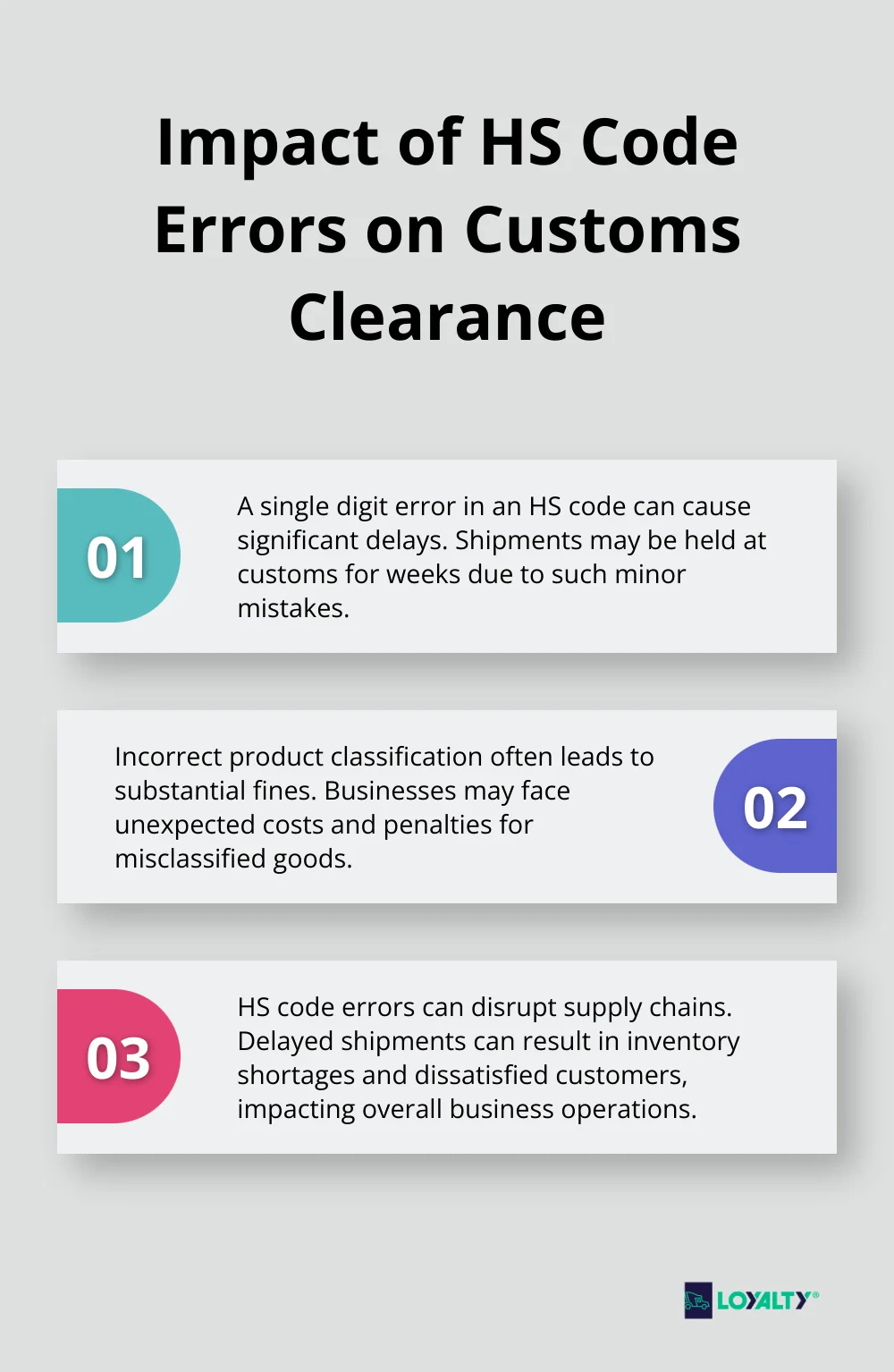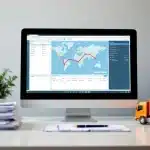Cross-border shipping presents a complex web of challenges for businesses expanding internationally. From navigating diverse customs regulations to managing logistics across multiple countries, the process can be daunting.
At Loyalty Logistics, we’ve seen firsthand how mastering these challenges can unlock new markets and drive growth. This guide will equip you with practical strategies to overcome common hurdles and streamline your cross-border shipping operations.
What Are the Key Cross-Border Shipping Regulations?
Customs Procedures Across Borders
Cross-border shipping regulations significantly impact shipping costs, delivery times, and success in foreign markets. Customs procedures differ widely between countries. The United States Customs and Border Protection (CBP) uses the Automated Commercial Environment (ACE) system for imports. Canada employs the Single Window Initiative (SWI), while Mexico relies on the Ventanilla Única de Comercio Exterior Mexicano (VUCEM) system. Each system has unique requirements and processing times that affect shipping timelines.
To navigate these differences effectively, businesses should work with customs brokers who specialize in target markets. These experts help understand local regulations and expedite the clearance process. Participation in trusted trader programs (such as C-TPAT in the U.S. or PIP in Canada) can lead to fewer inspections and faster border crossings.
Critical Documentation for Smooth Shipping
Proper documentation prevents delays and penalties. Most shipments require a commercial invoice, packing list, and bill of lading at minimum. Depending on the goods, certificates of origin, export licenses, or specific product certifications might also be necessary.
Incorrect product classification is a common pitfall. The Harmonized System (HS) codes used for classifying goods can be complex, and mistakes often lead to significant delays or fines. (In some cases, a single digit error in an HS code has resulted in shipments being held at customs for weeks.) To avoid this, businesses should use automated classification tools or consult with customs experts to ensure accuracy.

Navigating Tariffs and Duties
Tariffs and duties can dramatically affect the final cost of goods. These charges vary based on product type, origin, and specific trade agreements between countries. Under the USMCA (which replaced NAFTA in 2020), many goods move duty-free between the U.S., Canada, and Mexico if they meet specific origin requirements.
To optimize cross-border shipping strategy, businesses must stay informed about current trade agreements and potential changes. The World Trade Organization (WTO) and national customs websites provide up-to-date information on tariffs and duties.
De minimis thresholds also impact shipping costs. These are values below which imports are exempt from duties and taxes. (For example, the U.S. has a relatively high de minimis threshold of $800, while Canada’s is much lower at CAD 20.) Understanding these thresholds helps structure shipments more cost-effectively, especially for e-commerce businesses.
Technology and Compliance Tools
Advanced technology plays a vital role in managing cross-border shipping regulations. Many companies now use automated compliance software to streamline customs declarations, calculate duties and taxes, and ensure adherence to complex trade regulations. These tools can significantly reduce errors and expedite the clearance process.
Staying Ahead of Regulatory Changes
The regulatory landscape for cross-border shipping is constantly evolving. Trade agreements, tariff schedules, and customs procedures can change rapidly, often in response to geopolitical events or economic policies. Businesses engaged in international trade must establish systems to monitor these changes and adapt their shipping strategies accordingly.
As we move forward to discuss logistics and transportation management, it’s clear that a thorough understanding of cross-border regulations forms the foundation for successful international shipping operations. The next section will explore how to effectively manage the physical movement of goods across borders, building on this regulatory knowledge.
How to Optimize Cross-Border Logistics
Select the Optimal Shipping Mode
The right shipping mode balances speed, cost, and reliability. Air freight excels for time-sensitive shipments between the U.S. and Canada. Trucking or intermodal solutions offer better value for bulkier goods or longer distances (such as U.S. to Mexico routes).
Your goods’ nature dictates the mode. Perishables need temperature-controlled environments, requiring refrigerated trucks or reefer containers. Flatbed trucks accommodate oversized or oddly shaped items safely.
Intermodal transportation, which combines truck and rail, cuts costs for long-distance shipments. This method works best for non-urgent, high-volume cargo moving between major North American hubs.

Collaborate with Experienced Carriers
Carriers with extensive cross-border experience navigate complex customs procedures efficiently. This reduces delays and compliance issues. Look for carriers with a proven track record in your specific trade lanes and product types.
Evaluate potential partners’ network strength in your target markets. A carrier with established relationships with customs officials and local logistics providers expedites clearance processes and resolves issues quickly.
Harness Technology for Enhanced Visibility
Technology is essential in cross-border logistics. Advanced tracking systems provide real-time visibility into shipment status, allowing proactive management of potential delays or issues.
A Transportation Management System (TMS) that integrates with customs systems in your key markets streamlines documentation processes. This integration minimizes errors that could lead to costly delays.
GPS tracking and geofencing technology allow precise monitoring of shipments. This proves particularly useful for high-value or sensitive cargo, providing alerts when shipments enter or leave designated areas.
Data analytics tools identify patterns in your cross-border shipments, highlighting opportunities for route optimization or mode selection improvements. Analysis of historical data informs decisions that enhance efficiency and reduce costs over time.
Blockchain technology enhances transparency and security in cross-border logistics. It creates an immutable record of transactions and documentation, which reduces fraud risk and streamlines customs processes.
Optimize Packaging and Labeling
Proper packaging and labeling prevent damage and expedite customs clearance. Use sturdy materials that withstand the rigors of international transport. Ensure all labels are clear, accurate, and comply with destination country requirements.
Include all necessary information on labels, such as HS codes, country of origin, and any special handling instructions. This attention to detail minimizes the risk of delays or rejections at customs checkpoints.
Develop Contingency Plans
Cross-border shipping often faces unexpected challenges. Develop robust contingency plans for various scenarios, such as port strikes, weather disruptions, or sudden regulatory changes.
Maintain relationships with multiple carriers and consider alternative routes. This flexibility allows you to adapt quickly to disruptions and maintain supply chain continuity.
The optimization of cross-border logistics requires a multifaceted approach. From mode selection to technology adoption, each element plays a vital role in streamlining operations. However, even with the best planning, challenges can arise. The next section explores common hurdles in cross-border shipping and provides strategies to overcome them effectively.
How to Overcome Cross-Border Shipping Hurdles
Bridge Language and Cultural Gaps
Language barriers can cause misunderstandings and errors in cross-border shipping. Invest in professional translation services for all critical documents. Avoid free online translators as they often miss nuances that can alter the meaning of important information.
Cultural differences significantly impact business practices. For example, business practices and negotiation styles vary greatly between the U.S., Canada, and Mexico. In Mexico, personal relationships often precede business dealings, while Canada typically prefers a more direct approach.
To navigate these differences effectively, hire local representatives or partner with companies that have a strong presence in your target markets. These local experts provide invaluable insights into cultural norms and business practices, which helps avoid potential misunderstandings.
Navigate Currency Exchange and Payment Challenges
Currency fluctuations can significantly impact your bottom line in cross-border transactions. To mitigate this risk, use forward contracts to lock in exchange rates for future transactions. This strategy provides stability and predictability in your pricing.
Payment terms vary across borders. While 30-day payment terms are common in the U.S., other countries might expect longer terms. Adjust your payment policies accordingly, and clearly communicate your terms upfront to avoid disputes.
For secure transactions, use established international payment methods like letters of credit or escrow services. These provide protection for both parties and help build trust in new business relationships.
Mitigate Delays and Unexpected Costs
Delays and unforeseen expenses often frustrate cross-border shipping operations. To minimize their impact, add buffer time to your shipping schedules, especially for new routes or during peak seasons.
Unexpected costs frequently arise from customs issues. To avoid these, ensure meticulous and up-to-date documentation. Use a customs broker who specializes in your specific trade lanes. Their expertise prevents costly mistakes and expedites the clearance process.
Insurance is another critical aspect. While it might seem like an additional expense, comprehensive cargo insurance can save you from significant losses in case of damage, theft, or delays. (The International Union of Marine Insurance reports a 10% increase in marine cargo claims in the past year, highlighting the importance of adequate coverage.)

Leverage Technology for Proactive Management
Use technology to your advantage. Real-time tracking systems alert you to potential delays early, allowing you to take proactive measures. Some advanced systems even use AI to predict and suggest alternative routes based on historical data and current conditions.
Try to implement these strategies to reduce the impact of common cross-border shipping hurdles. Successful international shipping requires continuous learning and adaptation. Stay informed about changing regulations, market conditions, and technological advancements to keep your cross-border operations running smoothly.
Final Thoughts
Cross-border shipping challenges businesses to navigate complex regulations, optimize logistics, and overcome common hurdles. Companies that master these aspects unlock new markets and drive growth through strategic partnerships and technological innovation. Adaptability and continuous learning enable businesses to anticipate challenges and seize opportunities in the ever-changing world of international trade.
Successful cross-border shipping opens doors to new customer bases, diversifies revenue streams, and enhances supply chain resilience. Companies that excel in international logistics often experience increased operational efficiency, reduced costs, and improved customer satisfaction. These advantages contribute to long-term growth and stability in an increasingly interconnected global economy.
Loyalty Logistics offers comprehensive solutions for transportation across the U.S., Canada, and Mexico. We focus on timely, damage-free delivery and commit to sustainability (which helps businesses optimize their supply chains). Our expertise helps companies achieve success in cross-border operations and transform international shipping challenges into opportunities for expansion.


